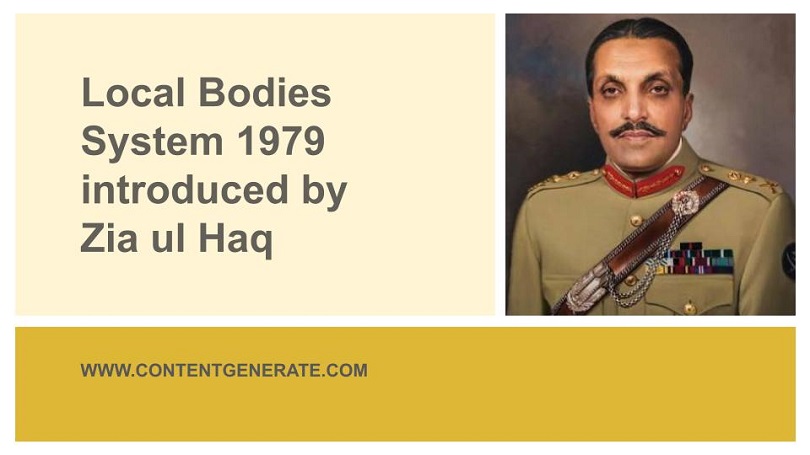Local Bodies System 1979 – Local Government System introduced by Zia ul Haq

This post presents an analysis and critique of the Local Bodies System introduced in 1979 by the military ruler General Zia ul Haq. You can also view a related PowerPoint Presentation from a link given at the end of this post.
Contents
Structure of the Local Bodies 1979
The military ruler General Zia-ul-Haq introduced a local government system “The Local Bodies System 1979” in Pakistan. Contrary to Ayub’s Basic Democracies system, the Local Bodies System 1979 was characterized with two tiers in rural areas and three to four tiers in urban areas depending upon the size of the town/city.
Rural Set-up
The lowest tier in rural areas was the union council. The union councilors indirectly formed Zila Council. The head of the council was called Chairman and Mayor in rural and urban areas respectively. Contrary to the Basic Democracies System 1959, the Tehsil Council and Divisional Council were not part of Zia’s local government system.
Urban Set-up
The local Bodies System for urban areas consisted of four layers, i.e.:
- Town Committee (for smaller towns),
- Municipal Committee (for larger towns),
- Municipal Corporation (for smaller towns),
- Metropolitan Corporation ( for larger towns).
Critique/Analysis in terms of merits and demerits
Given below is an analysis of the Local Bodies System 1971 in terms of its merits and demerits:
1. The first-ever local Council elections on basis of adult franchise
For the first time, the provincial governments held elections to local councils based on adult franchise in both villages and cities simultaneously all over the country including Gilgit-Baltistan, Federal Area, Tribal Areas, and Azad Kashmir.
2. Increased measures for local empowerment
Unlike the Basic Democracies System of Ayub Khan, there were no appointed or unofficial members in councils. Public representatives headed the councils and enjoyed significant autonomy. Now, they could make and approve decisions about their own budgets and taxation.
3. Most representative in nature since independence
The Local Bodies Government System 1979introduced in 1979 by General Zia-ul-Haq was the most representative in nature since independence. It provided representation for women, peasant workers in the councils. Moreover, it also provided reserved seats for minorities.
Although this representation was not enough, it was a step towards empowerment and inclusion of people in politics.
What were the Demerits of Local Bodies System 1979
1. Influence of provincial governments
Although the new system provided an increased measure of empowerment, still the councils were not independent enough. the provincial government could influence the councilors by using its authority of allocating funds for the councils.
2. Absence of constitutional protection
No constitutional protection was given to elected local councils as it was a presidential ordinance. This lack of constitutional protection put local governments vulnerable to the whims of bureaucracy and provincial government to suspend local government heads and make changes at their will.
3. The increased role of elite politics in rural areas
The new local government system provided a non-Party-based election. The restriction on political parties to contest elections led to an increased role of the rural elite who dominated rural politics.
4. Rural-Urban power Disparity
The system favored the Urban councils as they enjoyed higher levels of revenue than rural councils. In contrast, the rural and semi-urban councils were dependent on provincial governments for financial support.


